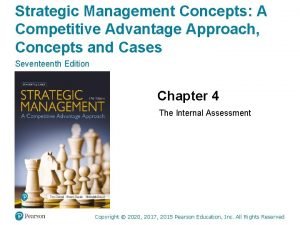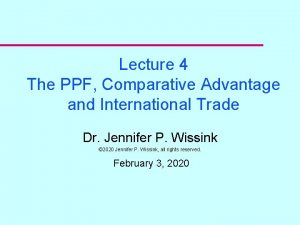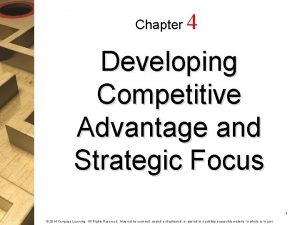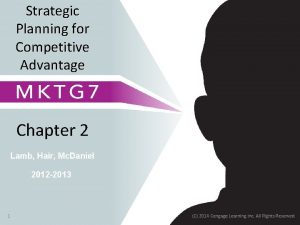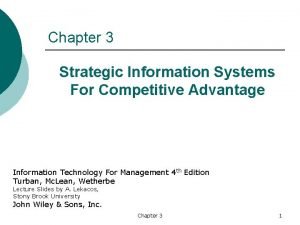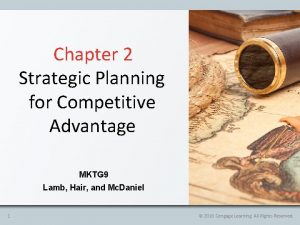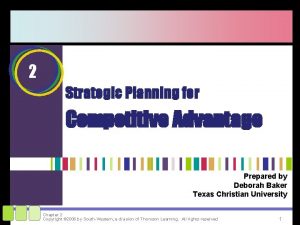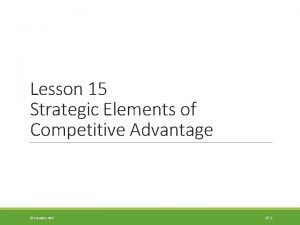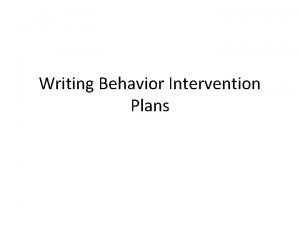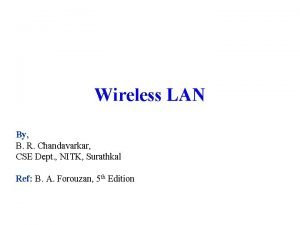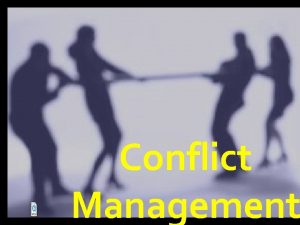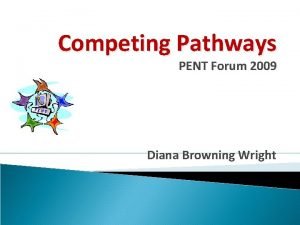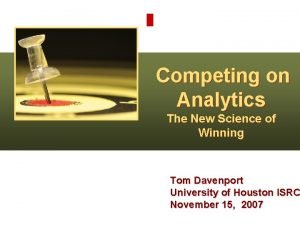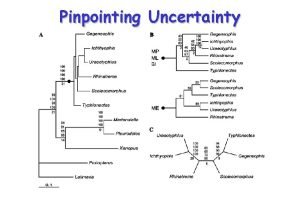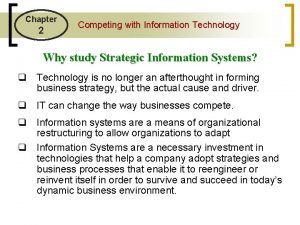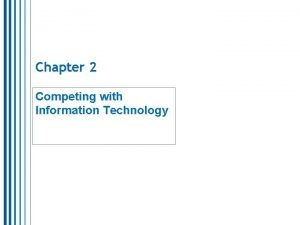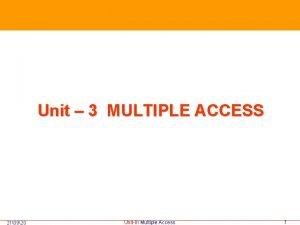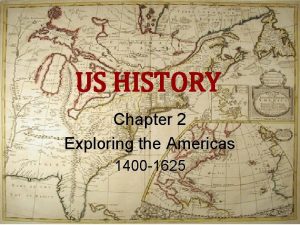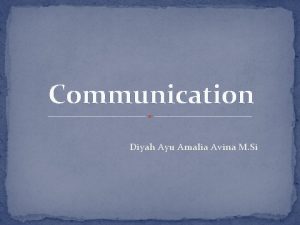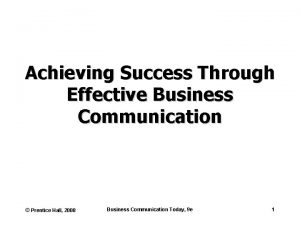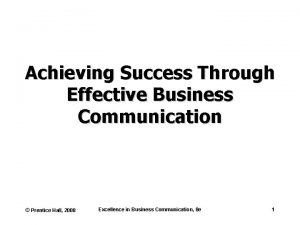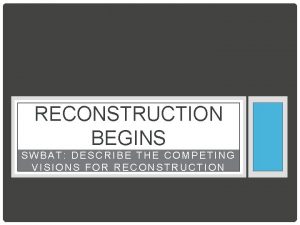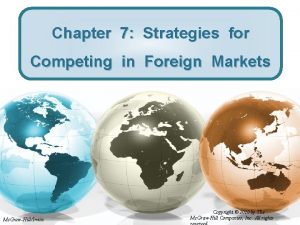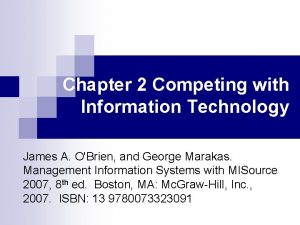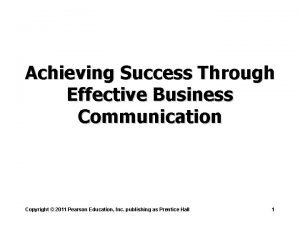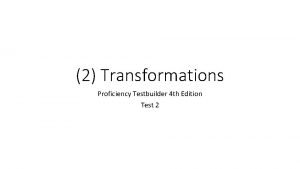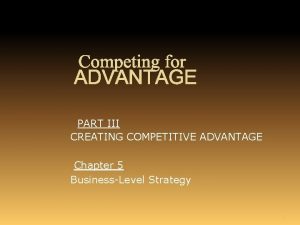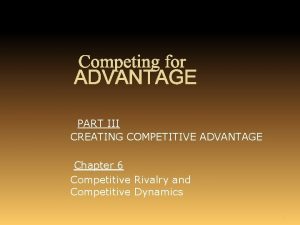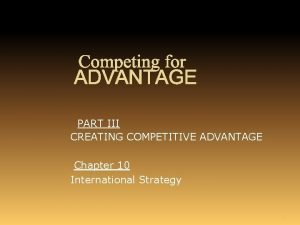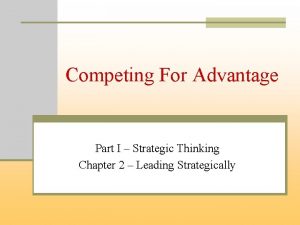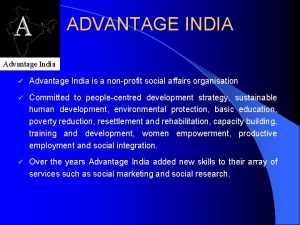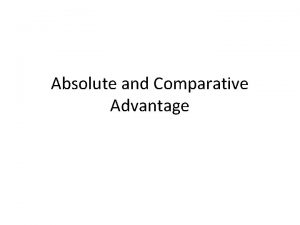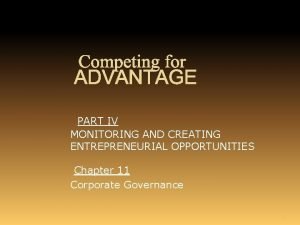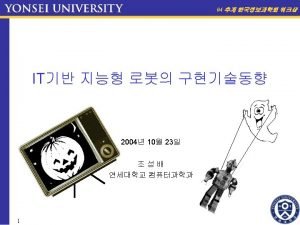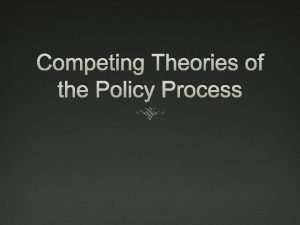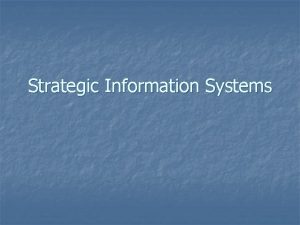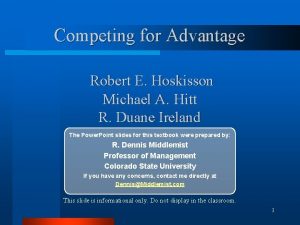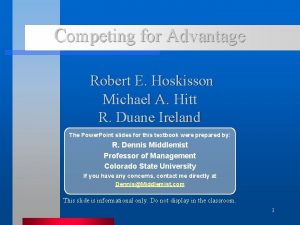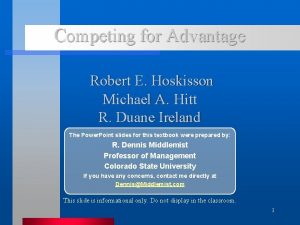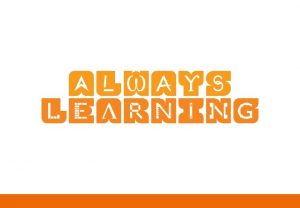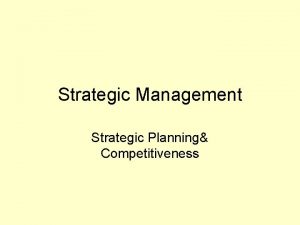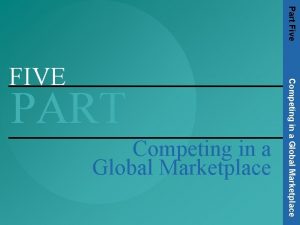Competing For Advantage Strategic Management Part I Strategic








































- Slides: 40

Competing For Advantage 競爭優勢: Strategic Management Part I – Strategic Thinking Chapter 1 – What is Strategic Management? These slides have been modified to meet the teaching needs of the class --- Celeste Ng

Content 1. Relationship between strategic management and competitive advantage 2. Competitive advantage 3. Strategic management

Relationship between strategic management and competitive advantage n Strategic Management n Strategic management combines the art and science of business management. 藝術 科學) 科學 management (策略管理結合了企業管理的藝術和 n It is a formalized process for developing, implementing and following a firm strategy. (正式的方式) n It allows a business to develop distinguished characteristics to position itself in the market. (他讓企業在市場裡開發傑出/ n 獨特的特徵) Strategic management is an effective tool for increased business performance and growth. n Competitive Advantage n A competitive advantage is an outstanding characteristic that makes a firm more desirable to consumers than the competition. (企業傑出/ 獨特的特徵) n Examples of competitive advantage include superior quality, lower price and better customer service. n A competitive advantage can arise because of a firm's competencies (是 因為公司的能力) Source: https: //bizfluent. com/info-7945019 -relationship-strategic-management-competitive-advantage. html, 2018.

Relationship between strategic management and competitive advantage Strategic management Organizational competencies or capabilities Competitive advantage • Organization cannot gain competitive advantage without organizational capabilities. • Strategic management is required in order to better transform organizational capabilities into (sustainable) competitive advantage

What is Competitive Advantage n Additional slides for this material is provided in the IM 520 course website (http: //celesteng. mis. yzu. edu. tw/im 520/ ) in the “Lecture slides”-section.

Sources of Competitive Advantage n n n Speed to market進入市場的速度 Access and use獲取和使用of information Rapid diffusion快速擴散(kuòsàn) of new, transformed knowledge轉變的知識 throughout the company Innovation Global standard achievement (e. g. , IFRS, ISO/IEEE related standards) Strategic flexibility戰略靈活性

NEW Competitive Landscape情景 rapid change and diffusion- 快速變化和擴散 Mindset -思維 Knowledge intensity -知識密集累積 Go

What is needed in the NEW Competitive Landscape 競爭格局? n n n Quick competitive information needs Shorter product life cycles更短的產品生命週 期 Rapid technology replacement技術取代 Availability of inexpensive information New business culture企業文化from electronic -business models (e. g. , in the Music, bookstore and newspaper industries) Continuous learning is necessary

Impacts of Disruptive Technologies 破壞性技術/科技 Its possible impacts: n Value of existing technologies is destroyed破壞 n Creative destruction process replaces existing technologies with new ones n New markets are created

What is “Business Strategy” n Additional slides for this material is provided in the IM 520 course website (http: //celesteng. mis. yzu. edu. tw/im 520/) in the “Lecture slides”-section.

Early Influences on the Strategy Concept n Agency Theory代理理論 – n n the idea that agency problems exist when managers take actions that are in their own best interests管理者採取符合自 己最佳利益的行動rather than those of shareholders股東 The use of Agency Theory to focus on shareholder returns as a primary criterion for firm success股東收益 作為首要標準公司成功 n Transactions Costs Economics交易成本經濟學 – examination of the efficiency of economic activity活動 的經濟效率that instructs firms to n n buy required resources through a market transaction, unless certain conditions exist that efficiently allow firms to create them internally

Three Perspectives of Modern Strategic Management Model (for Value Creation)價 值創造 n Strategic Management Model(企業戰略 管理模式) n n n Industrial/Organization (I/O) Economic Model 業/組織經濟模型 Resource-Based View資源基礎觀 Stakeholder Approach利益相關者方法

The Industrial/Organization (I/O) Model of Above-Average Returns高於 平均水平的收益 n Strategy selection is dictated by the structural characteristics of the industry in which it competes. n Basic Premise (starting assumption)基本前提of the I/O Model – to explain the dominant influence of the external environment外部環境 的影響on a firm's strategic actions and performance戰略行動和業績 n External environment Firm’s action

The Industrial/Organization (I/O) Model of Above-Average Returns n Underlying Assumptions n n That the external environment imposes pressures and constraints強加壓力和限制that determine the strategies判斷策略resulting in above-average returns That most firms competing within a particular industry行業or industry segment control similar strategically relevant resources控制類似的戰略 相關資源and pursue追求similar strategies in light of those resources

The Industrial/Organization (I/O) Model of Above-Average Returns n Underlying Assumptions (cont. ) n n That resources for implementing strategies are highly mobile流動性很大across firms, and that due to this mobility any resource differences between firms will be short lived 短暫的 That organizational decision makers are rational and committed理性並致力於to acting in the firm's best interests最佳利益, as shown by their profit-maximizing behaviors追求利潤 最大化的行為

1 -Study all 2 -Locate an industry The 3 -Identify the strategy Industrial/ Organization (I/O) Model 4 -Obtain required resources of Above. Average 5 -Implement the strategy Returns

The Industrial/Organization (I/O) Model of Above-Average Returns n. Examples of: Mc. Donald’s and Starbucks n Mc. Donald’s – CEO Ray Crock: was a sales rep銷售代 表for a firm that built malted milkshake machines麥芽奶 昔機. n Starbucks – CEO Howard Schultz: was a sales rep for a company that made home espresso machine accessories濃縮咖啡機配件. n They noticed that each was in an emerging industry that had high-growth potential and higher-than-average profit margins. n Mc. Donald’s is in fast-food快餐and drive-thru得來速 restaurants, and Starbucks is in specialty coffee retail特 種咖啡零售.

The Industrial/Organization (I/O) Model of Above-Average Returns n Strategy (implemented) that allows to achieve high profits Mc. Donald’s: Crock was able to use quality, consistency一致性, rapid assembly system快 速組裝系統(of burger), and drive-thru得來速 concepts of Mc. Donald’s to continue to realize high profits. n Starbucks: Schultz was able to use the Starbucks image, ambiance concept氣氛理念, and marketing strengths to rapidly expand. n

The Industrial/Organization (I/O) Model of Above-Average Returns n Limitations限制 n Only two strategies are suggested: n Cost Leadership低成本領先 n Differentiation差異化 n Internal resources and capabilities內部資源和 能力are not considered

The Resource-Based Model資源基礎 模型of Above-Average Returns n Strategy selection is dictated by the firm's unique collection of resources and capabilities n Key Terms n n n Distinctive Competencies特有的競爭優勢– attributes that allow a firm to pursue a certain strategy more efficiently than other firms Resources – inputs into a firm's production process, such as capital equipment資本設備, employee skills員 技能, patents專利, high-quality managers, financial condition, etc. Capability能力– capacity for a set of resources to perform a task or activity in an integrative manner一體 化的模式

The Resource-Based Model of Above -Average Returns n Key Terms (cont. ) n n n Core Competencies核心競爭力– a firm’s resources and capabilities that serve as sources of competitive advantage over its rivals Competitive Advantage – the successful formulation and execution of strategies成功的制定 和執行戰略that are different from and produce more value than the strategies of competitors Sustainable可持續Competitive Advantage (referred to as "Competitive Advantage" in text) – competitive advantage that is possible only after competitors' efforts to duplicate the value-creating strategy複製該價值創造戰略have ceased or failed

The Resource-Based Model資源基礎 模型of Above-Average Returns n Basic Premise (starting assumption) 基本前提 of the Resource-Based Model proposes that n a firm's unique resources and capabilities should define its strategic actions定義其戰 略行動and be used effectively to exploit opportunities in the external environment to ensure successful performance

The Resource-Based Model of Above -Average Returns n Three Categories of Resources n Physical物質 n Human人力 n Organizational capital組織資本 § Includes “its culture, structure, organizational learning, and processes” (http: //www 2. warwick. ac. uk/fac/soc/wbs/ conf/olkc/archive/oklc 5/papers/k 3_navas. pdf)

The Resource-Based Model of Above -Average Returns n Types of resources that become a competitive advantage must have the characteristics of § § Valuable有價值的 Rare難得的 Costly to imitate難以模仿 Nonsubstitutable不可替(tì)代

The Resource-Based Model of Above -Average Returns n Two types of core competencies 核心能力 n Managerial competencies管理 能力 n Product-related competencies 產品相關能力

The Resource-Based Model of Above -Average Returns n Managerial competencies管理能力 n are important in a firm’s ability to take advantage of its resources. n For example, the Palo Alto Research Center 帕洛阿爾托研究中 心 developed by Xerox in the 1970 s was the birthplace of the personal computer (PC), the laser printer, and the Ethernet區域 網(LAN)技術(all technologies subsequently exploited by other firms). Because Xerox managers did not foresee the value-creating potential of these technologies, they did not make efforts to commercially exploit them. lack of foresight Result: the Hewlett-Packard division that makes and sells laser printers has more total revenue than all of Xerox. n n

The Resource-Based Model of Above -Average Returns n Product-related competencies產品相關能力 n n n a firm’s capability to develop innovative new products and to reengineer existing products to satisfy changing consumer tastes. Firms must also continuously develop their competencies to keep them up-to-date Resource-based model suggests that core competencies are: n The basis for a firm’s competitive advantage and its ability to earn above-average returns

1 -Identify resources 2 -Determine capabilities The Resource 3 -Determine comp. advantage -Based Model of Above 4 -Locate an industry Average 5 -Select a strategy Returns

The Resource-Based Model of Above -Average Returns n According to Barney (1991): n (a) Resources that simultaneously enhance a firm’s market effectiveness (valuable) and are not widely dispersed (rare) can produce competitive advantage; and n (b) when such resources are concurrently expensive to imitate (inimitable) and costly to substitute (nonsubstitutable), the competitive advantage is sustainable. n Thus, both value and rarity are necessary before inimitability and nonsubstitutability might yield a sustainable competitive advantage (Priem & Butler, 2001).

The Resource-Based Model of Above -Average Returns n Limitations n n n Despite these findings and the intuitive appeal of RBV, challenges remain. Priem and Butler (2001) noted that a resource that is valuable, rare, hard to imitate, and not substitutable is also difficult to assess, manipulate操作部署, or deploy部署(bùshǔ), and therefore difficult to exploit利用. Their analytical assessment spurred an important debate regarding RBV’s practical utility 實用價�. For example, tacit knowledge隱含知識, organizational learning, workflow, time, interorganizational ties組織間關係, communications, and human interactions might be seen as hard to imitate and nonsubstitutable resources, but such resources are neither necessarily rare nor inevitably valuable.

The Stakeholder Model of Responsible Firm Behavior and Firm Performance n Key Terms n Stakeholders – individuals and groups that can affect (and are affected by) the strategic outcomes a firm achieves, and that have enforceable claims on a firm's performance n Strategic Intelligence – information that firms collect from their network of stakeholders and use to deal with diverse and cognitively complex competitive situations

The Stakeholder Model of Responsible Firm Behavior and Firm Performance n Basic Premise of the Stakeholder Model – to propose that a firm can effectively manage stakeholder relationships to create a competitive advantage and outperform its competitors

The Three Stakeholder Groups

Secondary Stakeholders n n Government entities and administrators Activists and advocacy groups Religious organizations Other nongovernmental organizations

The Stakeholder Model of Responsible Firm Behavior and Firm Performance

Ways Stakeholder Relationships Contribute to Competitive Advantage n n Timely and high quality strategic intelligence is gathered to improve a firm's strategic decisions A trustworthy reputation draws valuable customers, suppliers, and business partners to acquire or develop competitive resources A trustworthy reputation attracts investors to offer financial resources Firms that have fair and respectful treatment of employee relationships attract high-quality human resources

Ethical Questions What types of ethical issues and challenges do firms encounter when competing internationally?

Key Terms (1) n Key Terms n Globalization – increased economic interdependence增加了經濟上的相互依賴among countries as reflected in the flow of goods and services, financial capital金融資本, and knowledge across country borders跨國界(jiè) n Technological advances – Increasing rate of technological change and diffusion擴散, and increasing speed at which technologies become available可得到and are used Back

Key Terms (2) n Hypercompetition超級競爭– extremely intense rivalry among competing firms, characterized by escalating and increasingly aggressive competitive moves不斷升級和越來越競爭的招式 n n Aggressively challenge their competitors Competition to create new know-how and establish firstmover advantage, n Strategic Flexibility戰略靈活性– set of capabilities used to respond設置功能,用於回答 to various demands and opportunities existing in a dynamic and uncertain competitive Back environment

Key Terms (3) n “Industry structure, n manifested in the strength of the five competitive forces, determines an industry’s long-run profit potential because the forces shape the division of value among industry actors— whether profit is constrained by substitutes or new entrants, bargained away by customers or suppliers, or competed away by rivals. n By considering all five forces, a strategist keeps overall structure in mind instead of gravitating to any one element. In addition, attention is paid to long-run industry conditions rather than fleeting factors; industry structure is reflected in profitability over a business cycle, not in a single year, ” (Porter, 2007, page 8) Source: Porter, M. , 2007, “Understanding Industry Structure, ” Harvard Business Review, Report: 9 -707 -493, URL: http: //home. aubg. edu/students/MAN 130/Understanding-Industry. Structure 3. pdf Back
 Competing for advantage
Competing for advantage Strategic management a competitive advantage approach
Strategic management a competitive advantage approach Comparative advantage vs absolute advantage
Comparative advantage vs absolute advantage Actual mechanical advantage vs ideal mechanical advantage
Actual mechanical advantage vs ideal mechanical advantage Strategic competitiveness
Strategic competitiveness Cultural aspects of strategy choice
Cultural aspects of strategy choice Developing competitive advantage and strategic focus
Developing competitive advantage and strategic focus Strategic planning for competitive advantage
Strategic planning for competitive advantage Chapter 2 strategic planning for competitive advantage
Chapter 2 strategic planning for competitive advantage Strategic information system advantages and disadvantages
Strategic information system advantages and disadvantages Strategic planning for competitive advantage
Strategic planning for competitive advantage Strategic planning for competitive advantage
Strategic planning for competitive advantage Searching for loose bricks
Searching for loose bricks Intervention
Intervention Ten thousand airline reservation stations are competing for
Ten thousand airline reservation stations are competing for Owl conflict management style
Owl conflict management style Competing pathways chart
Competing pathways chart Competing with analytics
Competing with analytics Competing pathways examples
Competing pathways examples Analysis of competing hypotheses template
Analysis of competing hypotheses template Competing with information technology
Competing with information technology Competing with information technology
Competing with information technology Ten thousand airline reservation stations are competing for
Ten thousand airline reservation stations are competing for Lesson 4 competing for colonies
Lesson 4 competing for colonies Competing messages communication barriers
Competing messages communication barriers Difinition communication
Difinition communication Competing for colonies
Competing for colonies Competing messages communication barriers
Competing messages communication barriers Competing messages communication barriers
Competing messages communication barriers The competing visions of reconstruction
The competing visions of reconstruction Strategies for competing in international markets
Strategies for competing in international markets Competing with information technology
Competing with information technology Competing messages communication barriers
Competing messages communication barriers Competing behavior pathway example
Competing behavior pathway example Competing with information technology
Competing with information technology They still haven't found out what caused the accident
They still haven't found out what caused the accident Fspos
Fspos Typiska novell drag
Typiska novell drag Nationell inriktning för artificiell intelligens
Nationell inriktning för artificiell intelligens Vad står k.r.å.k.a.n för
Vad står k.r.å.k.a.n för Varför kallas perioden 1918-1939 för mellankrigstiden?
Varför kallas perioden 1918-1939 för mellankrigstiden?

